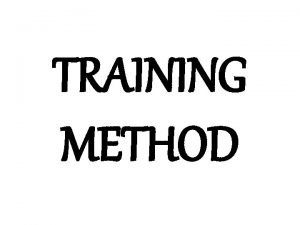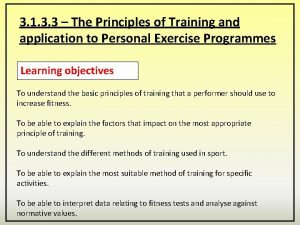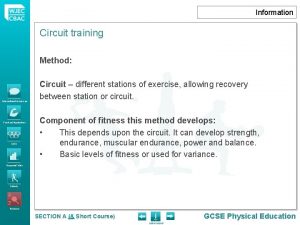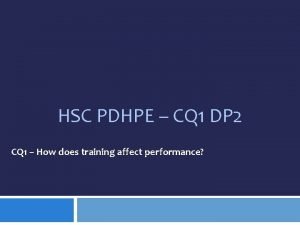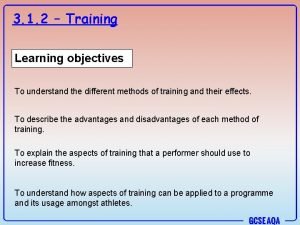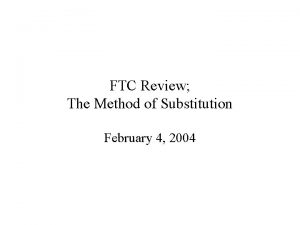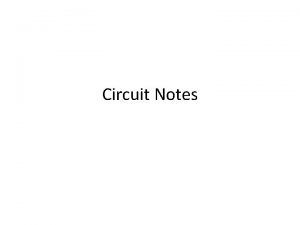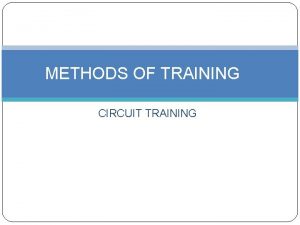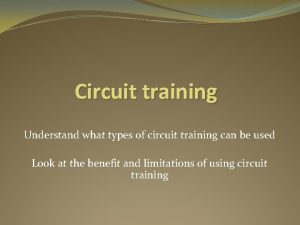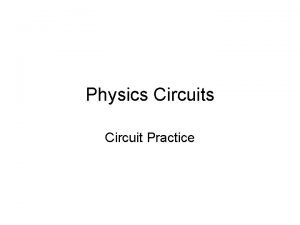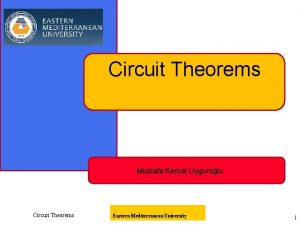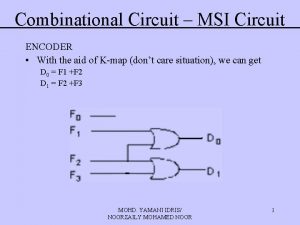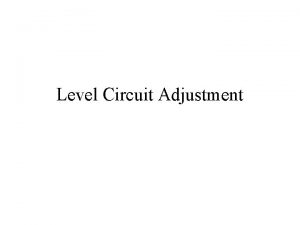TRAINING METHOD TRAINING METHOD 1 Circuit Training Method
























- Slides: 24

TRAINING METHOD

TRAINING METHOD: 1. Circuit Training Method 2. Interval Training Method 3. Repetition Training Method 4. Fartlek Training Method 5. Weight Training Method

1. Circuit Training Method Circuit training method was developed by R. E. Morgan and G. D. Adamson in 1953 at the University of Leeds, England. This type of conditioning involves almost all of the training factors. Circuit training can be designed to develop strength, power, muscular, endurance, speed, agility, neuromuscular coordination, flexibility and cardiovascular endurance. Circuit training typically involves a series of different exercises that you perform sequentially and continuously for one or more rounds. That is, you select several specific exercises and move quickly from station to maximize both training effectiveness and time-efficiency.

Muscular strength is developed through higheffort anaerobic activity, which fatigues the target muscle groups within 90 seconds of resistance exercise. In the past, people typically performed three sets of each strength exercise, resting two to three minutes between successive sets for sufficient muscle recovery. Of course, this resulted in relatively long training sessions , with much more time spent resting than exercising. To reduce the workout duration, with a minimum percentage of resting time and maximum percentage of activity time, circuit training involves one set of an exercise followed as quickly as possible by one set of another exercise for a different muscle group.

Here is an example of a circuit designed for footballers. star jumps dribbling press-ups keepyuppy 2 MINUTE STATIONS passing sideways jumps sit-ups sprints


Disadvantages of circuit training • It can be very time consuming to set up and organize • People can get in each others way if the circuit is busy and performed in a small area

Advantages of circuit training • It is less boring due to all of the exercises being different • It is easily adaptable and can be set up in both indoors and outdoors • It is physically beneficial because you are improving your anaerobic and aerobic fitness You can target specific muscle groups. You can include weight training activities to increase strength. You can increase the length of each activity to train the aerobic system. You can include skill-based activities.

2. Interval Training Method �Interval training involves times of work followed by times of slower work or rest. �It is an exercise strategy that is intended to improve performance with short training sessions. The term can refer to any cardiovascular workout. �This involves periods of work followed by periods of rest. �The work interval may be a distance to run, say 60 m, or a time to run, say 10 secs. �The rest interval may be a walk back to the starting mark, or simply not working (rest).

INTERVAL TRAINING is particularly suitable for team game players, as it consists of short bursts followed by slow walking or stopping. 1. It includes repeated sprint running or swimming, which is ANAEROBIC. 2. It takes place over short periods or bursts 3. It includes a rest period which allows for recovery 4. It includes repetitions of high quality, which raises the pulse into the TRAINING ZONE.

This training method is popular with performers who have to cover specific distances e. g. cyclists, rowers, swimmers- it allows them to work under or over their distances to set personal targets in terms of time. Interval training us to train for longer periods of time and can be used to develop both anaerobic and aerobic fitness depending on how we organize our training sessions

Cycling Running Rowing

Advantages & Disadvantages Advantages: • It is physically beneficial because you are mixing both aerobic and anaerobic exercise together • Good method to set personal targets and goals to enhance fitness, performance and motivation Disadvantages: • It can be repetitive and dull if new targets are not set • It can be disheartening if the performer cannot reach the required goal. Must ensure that the targets set are achievable to the individual

3. Repetition Training Method: Repetition method regards as exercises which corresponds in parts to the requirements of competition being repeatedly performed during the training session. The intensity characteristics depends on the actual level of performance or aims and objectives of the training year. Breaks should be provided for complete recovery as possible.

Continuous training is the simplest form of training. As the name suggests, it involves training with no rest periods or recovery intervals. This type of training is a good way to improve your aerobic energy system. Swimming, running and cycling are common examples of continuous training activities. You need to work for a minimum of 20 minutes to achieve some kind of benefit. The more fit you become, the longer you will be able to work for.

As fitness improves, you will also be able to sustain a higher level of intensity. You should start training at about 60% of your maximum heart rate (MHR) increasing to around 75%– 80% as your level of fitness improves. Continuous training depletes your carbohydrate stores. As the body needs an energy supply to keep working, it is forced into using fat supplies. This means that continuous training is a good way to burn fat and lose weight. Continuous training doesn’t just mean running. Aerobics is a popular form of continuous training. It is usually performed to music and requires the performer to coordinate whole body movements.

4. Fartlek Training Method Fartlek training was developed in Sweden. It usually involves running, though you could apply the same principles to other activities like cycling and swimming. Fartlek is derived from the Swedish term meaning ‘speed play’. Essentially, this training involves many changes of speed. Intensity can also be varied, e. g. , by running uphill or downhill. Like interval training, Fartlek training is good for performers in activities requiring changes of pace and sudden bursts.

Advantages Fartlek training can be used to improve both the aerobic and anaerobic systems by mixing moderate activity with bursts of speed. It can be varied to suit the fitness level of each individual performer and the available time they have to train. This type of training can be used to avoid boredom in sports like running and cycling which can be monotonous.

Disadvantages As the performer decides on the intensity of work, it can be hard for coaches to tell if performers are working as hard as they should be.

All of these performances could be improved from fartlek training.

5. Weight Training Method WEIGHT TRAINING is a form of training that is most commonly used to improve strength and muscular endurance. It requires a resistance, usually in the form of a dumb bell, barbells or modern weight training (resistance) machines. Weight training makes use of the progression principle of training by gradually increasing the amount of weight handled.

Weight training is an effective way of improving a performer’s strength. Weight training is usually anaerobic. However, aerobic weight training can be achieved by using very light weights over a long training time. Weight training is useful in several different ways: It can improve muscular strength. It can improve muscular endurance. It can improve speed. It can aid rehabilitation after an injury.

Ten Golden Rules of Weight Training Method: 1. Concentrate on the muscles while exercising. 2. Maintain a good rhythm during exercise. 3. Knees and elbows should be soft during most exercises. Knee and elbow joint should not be fully extended. 4. Inhale during positive stroke, exhale during negative stroke. 5. Always begin with smaller/light weight. 6. Start with larger muscles. E. g. bench press before curls.

7. Rest between sets for 30 -60 sec and then begin the new set. 8. Rest for 48 hours between workout for muscles recovery. 9. Take professional help to chalk out your programme, learn correct technique. 10. Warm up and stretch before workout and cool down after weight training.
 Disadvantages of a parallel circuit
Disadvantages of a parallel circuit Types of circuit
Types of circuit Circuit construction kit
Circuit construction kit Series vs parallel circut
Series vs parallel circut Incomplete circuit
Incomplete circuit Resistor in parallel with short circuit
Resistor in parallel with short circuit Series and parallel circuits similarities
Series and parallel circuits similarities Pulmonary circuit and systemic circuit
Pulmonary circuit and systemic circuit What is a parallel circuit in physics
What is a parallel circuit in physics The circuit training method was developed in
The circuit training method was developed in Advantages of circuit training gcse pe
Advantages of circuit training gcse pe Circuit training standardized test prep answers
Circuit training standardized test prep answers Athlete resting heart rate
Athlete resting heart rate Advantages and disadvantages of circuit training
Advantages and disadvantages of circuit training Materi circuit training
Materi circuit training Circuit training diagram
Circuit training diagram Circuit training methods
Circuit training methods Hydraulic training pdhpe
Hydraulic training pdhpe Circuit training objectives
Circuit training objectives Circuit training properties of definite integrals
Circuit training properties of definite integrals Circuit rider training program
Circuit rider training program Cascade method pneumatic circuit design
Cascade method pneumatic circuit design Test source method circuit analysis
Test source method circuit analysis Importance of symposium in education
Importance of symposium in education Training is expensive without training it is more expensive
Training is expensive without training it is more expensive









